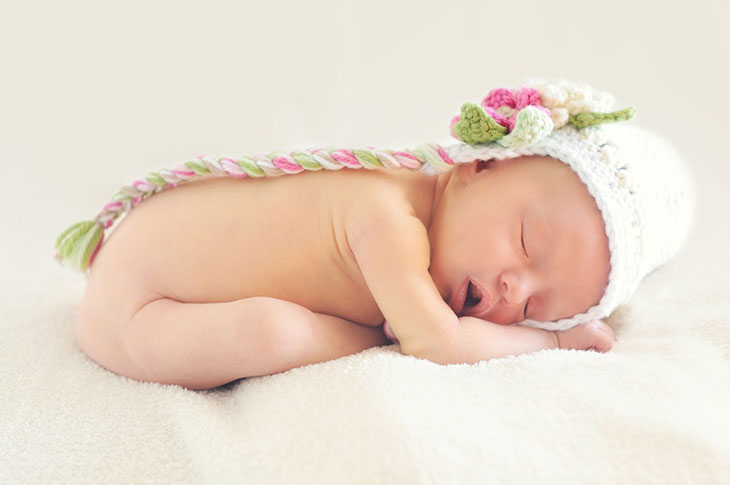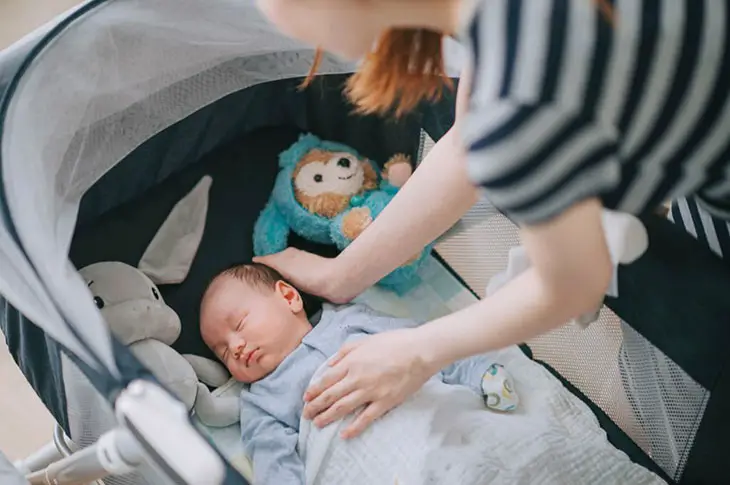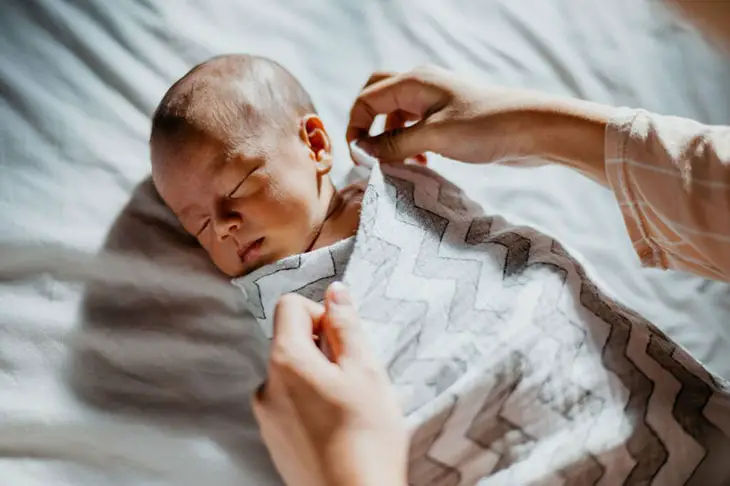Ever walked into the nursery and found your little nugget snoozing away in the most unexpected positions?
It is a head-scratcher when you see your tiny tot sleeping while sitting up, folded in half like a sandwich!
A baby sleeping sitting up folded in half is a real-life drama that takes place in the cribs of many confused parents.
To most people, this position looks amusing. As parents, however, you may wonder whether it is uncomfortable or even dangerous for your little ones.
In today’s article, I will “unfold” the reasons behind this odd position and what it means for their well-being. Let’s begin, shall we?
Why Is My Baby Sleeping Sitting Up Folded In Half? 4 Possible Reasons

In many cases, a baby sleeps sitting up as a response to pain or discomfort.
They may also try to explore their personal space or perform the act of “burrowing” with this seemingly awkward position.
By observing additional signs, you can pinpoint the motivator for this peculiar pose and decide whether intervention is necessary. Below, I will dive into the four common reasons:
Pain
With their still-developing digestive systems, our babies occasionally wrestle with pains that are alien to adults.
Gastrointestinal issues like gas and reflux can lead to significant discomfort for infants.
As babies fold themselves, pulling their legs toward their abdomens, it can provide gentle pressure that helps relieve this distress.
The posture mimics the fetal position, which is not only familiar and comforting but also helpful for passive gas expulsion. What is the surprising part?
Your baby chooses this position instinctively!
While it is quite rare for babies to experience back pain due to the robustness and flexibility of their young bodies, they sometimes deal with mild strain or discomfort in the back region as they learn to crawl.
This can be another reason your little one sleeps sitting up – they just want to avoid sleeping on their back at all costs.
If pain is the reason behind your infant’s unusual sleeping pose, you may notice additional signs of distress, such as inconsolable crying, restlessness, or disruptions in feeding.
Consult a pediatrician right away to ensure adequate solutions.
Comfort
Our infants come from the utero environment – a compact, enveloping space where the curled-up position is natural and necessary.
The physical memory of this comforting enclosure may linger even when they embrace the expansiveness of the outer world.
Subsequently, babies try to replicate this experience by adopting a folded-in-half position during sleep.
This seems antithetical to adult concepts of comfort, but returning to this primal pose offers infants a soothing, reminiscent tranquility.
Space
As babies gradually acquaint themselves with their bodies and the sprawling world around them, exploring space becomes a fundamental part of their development.
Unlike adults, our little ones possess a remarkable range of flexibility, allowing them to adopt an array of positions without experiencing the discomfort that would be inherent for older individuals.
This exemplary flexibility, together with the physical exploration of space, leads to various sleeping postures. Sleeping sitting up folded in half is just one of them.
Reminiscent Of An Embrace
When a baby falls asleep sitting up, the pose resembles how they are held in their parents’ arms.
This folded posture is also reminiscent of how infants position themselves during breastfeeding. That’s why they unconsciously mimic this pose.
Babies love the soothing sound of their parents’ heartbeats, so slinging them is the easiest way to lull them to sleep.
That’s why many babies love sleeping on your chest. However, avoid sitting down and nodding off yourself while carrying a baby.
Snoozing on a sofa with a baby can be extremely hazardous. If your infant displays a folded posture while sleeping against you, relish these precious moments and try to stay awake!
Is It Safe For Baby To Sleep Folded In Half?

While it might provide your little one with some comfort, sleeping folded in half is not quite safe for babies.
According to the American Academy of Pediatrics (AAP), here are the reasons why this position is not recommended:
- Airway obstruction: A folded position causes the baby’s chin to press against the chest, potentially obstructing the airway and leading to breathing difficulty.
- Re-breathing carbon dioxide: A folded or curved breathing position can create a small pocket around the baby’s nose and mouth, especially if they are nestled into soft bedding.
This causes them to re-breathe their exhaled air. Continuous breathing of carbon dioxide can lead to hypoxia (lack of oxygen) and accidental suffocation.
- Straining on neck muscles: Holding the head and neck in a bent position for an extended period can strain the baby’s neck muscles, potentially impacting their spine alignment.
- Improper spine development: Babies’ spines are developing and need to be supported appropriately. Prolonged periods in a folded position may impact spinal development.
What Should You Do In This Case?
So when your baby decides that sitting up folded over is their chosen slumber position, how should you respond?
The following guidelines can help ensure your little one is safe and sound as they dream!
Make Sure Your Baby’s Head Is Not Slumped Forward
As mentioned, a baby sleeping with their head slumped forward is an instant red flag regarding their breathing.
Ensuring a free, unobstructed airway is paramount to preventing critical situations like Stridor or even SIDS.
If necessary, carefully and gently adjust your baby’s head position to avoid any forward slumping.
Make sure that the neck and spine are in a neutral position to prevent any additional strain on these developing areas.
Keep An Eye On Your Baby
Vigilant supervision can never be emphasized enough, especially during a baby’s sleep when positions can shift and become precarious.
It is advisable to invest in a quality baby monitor, possibly one with video capabilities, to keep a close eye without being intrusive.
Another way to watch over your little one is to have them sleep in the same room (not on the same bed) as parents.
This allows you to facilitate quicker responses to any unusual movement or noise.
If your baby sleeps in another room, regularly peek into their sleeping area to ensure they maintain a safe position throughout their nap or nighttime sleep straight from 7 pm to 7 am.
Avoid Using Loose Bedding
Loose bedding can be a hidden threat, especially when a baby sleeps in an unconventional position.
A folded-over position increases the likelihood of a baby burying their face into loose bedding, which presents a significant risk of suffocation or re-breathing exhaled air.
To establish a safe sleeping space, use a firm mattress to minimize risk. Let your baby sleep on a flat surface, and keep plush toys or pillows away from the sleeping area.
While shopping for sleepwear, opt for a one-piece sleeper or wearable blanket to keep your little one warm without needing a loose blanket.
Help Your Baby Lie Down
Encouraging and guiding your baby to lie down from a sitting position can be both a preventive measure and a solution when you find them sleeping in a peculiar pose.
Here is a quick guide to a safe position:
- Gentle re-positioning: As soon as you see your baby sleeping sitting up, gently ease them into a safer, flat position on their back without startling them.
- Encouraging back sleeping: Make a habit of placing your little one on their back during sleep time to foster this preferred position.
- Creating a consistent sleep routine: By developing a stable and consistent sleep routine that incorporates lying down, you can slowly teach your infant the safest way to fall asleep.
What Is The Recommended Sleeping Position For Babies?

The safe sleeping position for babies, especially newborns and infants up to a year of age, is on their back.
This recommendation is supported by extensive research from numerous health organizations, including the American Academy of Pediatrics (AAP).
Let’s go through some key reasons why the back-sleeping position is encouraged:
Airway Protection
While the sitting-up position might block the airway, sleeping on the back keeps the baby’s airway open. This reduces the likelihood of obstruction and facilitates easier breathing.
Additionally, sleeping on the back prevents the baby from pressing their face against the mattress.
Lying face down may impede breathing and increase the risk of re-breathing exhaled air, which leads to carbon dioxide accumulation.
Reduced Risk Of SIDS
Due to its effect on protecting the airway, sleeping on the back can reduce the risk of Sudden Infant Death Syndrome (SIDS).
The “Back To Sleep” campaign (now known as “Safe To Sleep”) emphasizes the importance of placing babies on their backs while they are sleeping.
Since its inception, the campaign has been associated with a significant decrease in SIDS incidents.
Preventing Facial Deformities
Back sleeping can also help prevent positional plagiocephaly (flattening of the head’s back) and facial deformities.
With this position, the pressure on the skull is more evenly distributed than when the baby sleeps on their stomach.
For the reasons above, it is crucial to maintain the back-sleeping position consistently until the baby is 1 year old.
Once your infant learns to roll over independently (which often happens between 4 and 6 months of age), they may choose their sleep position.
However, always start every sleep time with your little one on their back, and ensure their sleeping area is free from potential hazards.
FAQs
When Should I Consult A Healthcare Professional About My Baby’s Sleep Position?
You should consult a healthcare professional about your baby’s sleep position if you notice any unusual patterns, such as consistently sleeping with the head tilted to one side, always preferring one sleeping position, or adopting awkward sleeping positions.
Furthermore, if your little one experiences difficulty breathing, exhibits restless sleep, or can’t maintain a safe sleeping posture, it is advisable to seek professional advice to address any underlying issues.
What Are The Signs Of Sudden Infant Death Syndrome (SIDS)?
Sudden Infant Death Syndrome (SIDS) is distressing because it occurs without warning.
The syndrome doesn’t have signs or symptoms that can be recognized ahead of time, but some factors are associated with a higher risk of SIDS:
- Sleeping on the stomach or side: Babies who prefer to sleep on their stomachs or sides have a higher risk of unexplained death.
- Premature birth or low birth weight: Infants who are premature or have a low birth weight are at increased risk.
- Exposure to cigarette smoke: Babies who are frequently exposed to cigarette smoke have a higher chance of SIDS.
- Being male: Male infants are more likely to die of this syndrome.
- Sleeping on a soft surface or with bedding: SIDS risk increases when sleeping on a soft mattress with stuffed toys or pillows.
Wrapping Up
When you find your baby sleeping sitting up folded in half, it is more than a quirky little snooze position.
While the pose might appear harmless and even cute at first glance, it should raise a red flag for all parents and caregivers out there.
Vigilant observation, gentle intervention, and fostering an optimal sleep environment are paramount to preventing any risk of SIDS.
Make sure to place a lens of caution on your baby’s sleep habits to ensure that every slumber is safe and peaceful.
